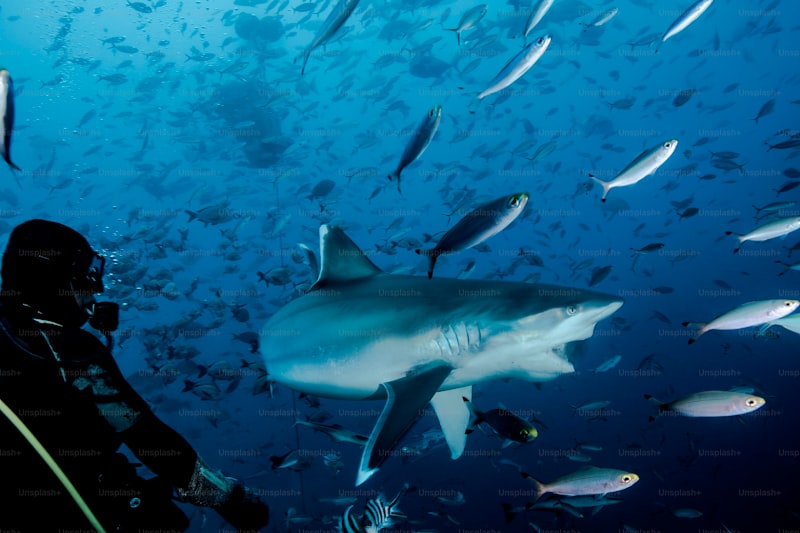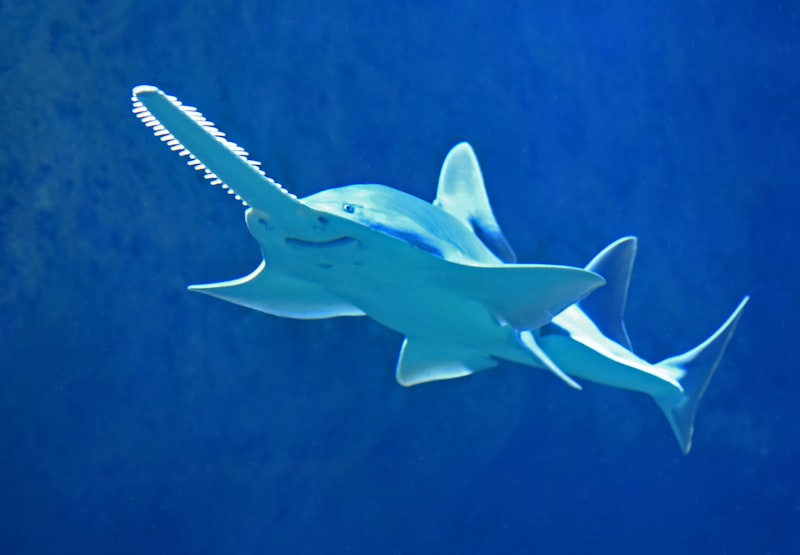One of the key initiatives in shark conservation is the establishment of marine protected areas (MPAs). These areas act as sanctuaries where sharks can thrive without the threat of fishing or other human disturbances. By safeguarding their habitats, MPAs help ensure that shark populations remain stable and healthy.
Another critical aspect of shark conservation is raising awareness among the public. Many people still fear sharks due to misconceptions fueled by media sensationalism. Conservation efforts focus on educating the public about the importance of sharks in marine ecosystems and debunking myths about their behavior. When people understand that sharks are not mindless killers but essential components of healthy oceans, they are more likely to support conservation initiatives.
In addition to protective measures and education, scientific research plays a vital role in shark conservation. Researchers study shark behavior, migration patterns, and population dynamics to inform conservation strategies. By gathering data on shark populations, scientists can identify endangered species and propose measures for their protection.
International cooperation is also crucial in shark conservation efforts. Sharks are highly migratory and often traverse international waters, making coordinated conservation efforts essential. Organizations like the International Union for Conservation of Nature (IUCN) work with governments and NGOs worldwide to develop policies and regulations that promote shark conservation on a global scale.
Overall, while challenges remain, there is hope for the future of sharks. Through collaborative efforts, scientific research, and public awareness, we can ensure that these magnificent creatures continue to roam the oceans for generations to come.
Global Initiatives: How Countries Are Banding Together for Shark Conservation
Why all the fuss about sharks? Well, these apex predators play a crucial role in maintaining marine biodiversity. They regulate the balance of species below them in the food chain, ensuring that ocean ecosystems remain healthy and resilient. Without sharks, the delicate harmony of marine life could tip out of balance, affecting everything from fish stocks to coral reefs.
So, what are countries doing to protect these ocean giants? One key initiative is the establishment of marine protected areas (MPAs). These are designated zones where fishing and other activities harmful to sharks are restricted or prohibited. MPAs serve as safe havens where sharks can thrive without the constant threat of human interference.
Another crucial aspect of global shark conservation efforts is international collaboration. Countries are joining forces to enact regulations and policies that transcend borders. By working together, they can create more effective strategies for managing shark fisheries and combating illegal fishing practices that endanger these vulnerable species.

Moreover, education and awareness are vital components of shark conservation. Public outreach programs inform communities about the importance of sharks and dispel myths that have led to their persecution. When people understand why sharks are critical to the health of our oceans, they are more likely to support conservation efforts and advocate for change.
Global initiatives for shark conservation are more than just a trend—they are a lifeline for species teetering on the brink of extinction. By banding together, countries can ensure a future where sharks continue to roam the oceans, their presence a testament to our commitment to preserving biodiversity for generations to come.
From Policy to Action: Key Strategies Driving Shark Protection Worldwide
Sharks, once feared predators of the deep, are now at the forefront of global conservation efforts. From policy frameworks to on-the-ground actions, a concerted global effort is underway to protect these majestic creatures that play a crucial role in marine ecosystems.
Governments worldwide have enacted stringent policies aimed at safeguarding shark populations. These policies range from international agreements like the Convention on International Trade in Endangered Species (CITES) listing certain shark species under protection, to national laws prohibiting shark finning and promoting sustainable fishing practices. Such measures form the backbone of shark conservation strategies, setting legal boundaries and expectations for sustainable practices.
However, policy alone is not enough. Effective enforcement and implementation are critical. Conservation organizations and local communities are pivotal in translating policy into action. They engage in monitoring shark populations, patrolling marine reserves, and educating fishermen on sustainable practices. By working closely with stakeholders, these groups ensure that regulations are not just on paper but are actively enforced in oceans around the globe.
Moreover, public awareness campaigns are instrumental in garnering support for shark conservation. These campaigns highlight the plight of sharks, dispelling myths and showcasing their importance in maintaining healthy oceans. Analogous to “guardians of the seas,” sharks are pivotal in regulating marine ecosystems, their decline often indicative of broader ecological imbalance.

As we navigate the complex waters of global conservation, each step taken towards protecting sharks resonates far beyond the ocean’s surface. It reflects our commitment to preserving biodiversity, ensuring sustainable fisheries, and leaving a thriving marine legacy for future generations.
Success Stories: Rescuing Endangered Shark Species Through Conservation
Imagine the depths of the Pacific Ocean where teams of marine biologists and conservationists collaborate tirelessly. Their mission: to protect and restore dwindling shark populations. Through a combination of scientific research, policy advocacy, and community engagement, these efforts have yielded remarkable results.
One such initiative unfolds in the waters off the Galápagos Islands, where marine sanctuaries serve as safe havens for endangered species like the scalloped hammerhead. Here, strict regulations on fishing practices and the establishment of protected marine reserves have contributed to a resurgence in shark numbers. It’s a testament to the power of proactive conservation strategies in reversing the tide of species decline.
Elsewhere, in the coral reefs of Australia’s Great Barrier Reef, innovative tagging technologies provide critical insights into the movements and behaviors of tiger sharks. By understanding their migratory patterns, conservationists can advocate for sustainable fishing practices and advocate for responsible tourism, ensuring these apex predators continue to play their vital role in marine ecosystems.
Back on land, educational programs and outreach initiatives are empowering local communities to become stewards of their coastal environments. In places like Costa Rica and South Africa, ecotourism centered around shark conservation has not only raised awareness but also provided sustainable livelihoods for communities formerly reliant on shark fishing.
Innovative Technologies Making Waves in Global Shark Conservation
Shark conservation efforts have seen a remarkable shift in recent years, driven by cutting-edge technologies that are revolutionizing how researchers study and protect these majestic creatures. From satellite tagging to advanced underwater drones, these innovations are crucial in understanding shark behavior, migration patterns, and threats they face in their ecosystems.
One of the most impactful technologies is satellite tagging, which allows scientists to track sharks across vast oceanic expanses. These tags, attached to the shark’s dorsal fin, transmit valuable data such as location, depth, and water temperature in real-time. This information provides insights into their movements, helping researchers identify critical habitats and migration routes essential for conservation planning.
Underwater drones equipped with high-resolution cameras and sensors are also playing a pivotal role. These drones can navigate challenging marine environments to observe sharks without disturbing them. They capture detailed footage of shark behavior and interactions with their surroundings, offering scientists unprecedented visual data for research and conservation efforts.
Furthermore, genetic technology has advanced significantly, enabling scientists to analyze shark populations at a molecular level. By studying DNA samples obtained non-invasively from the environment (eDNA), researchers can estimate species diversity and population sizes more accurately. This method is less intrusive and provides insights into the health and genetic diversity of shark populations worldwide.
Remote sensing technology, including satellite imagery and aerial surveys, complements these efforts by monitoring changes in shark habitats and identifying potential threats such as illegal fishing activities or habitat degradation. These tools enable conservationists to take proactive measures to protect vulnerable shark species before their populations decline further.
The integration of these innovative technologies marks a new era in shark conservation, offering hope for the future of these apex predators. By leveraging satellite tagging, underwater drones, genetic analysis, and remote sensing, researchers can gather comprehensive data essential for effective conservation strategies. As technology continues to evolve, so too will our ability to safeguard sharks and preserve the delicate balance of marine ecosystems they inhabit.
Breaking Barriers: Challenges Faced by Conservationists in Saving Sharks
Conservationists dedicated to protecting sharks face a myriad of challenges in their mission to safeguard these majestic creatures. Sharks, often misunderstood and unfairly vilified, play a crucial role in marine ecosystems. Despite their importance, they are under significant threat worldwide due to various human activities.
One of the foremost challenges conservationists encounter is the pervasive practice of shark finning. This cruel practice involves catching sharks, slicing off their fins, and discarding the rest of the body back into the ocean. The demand for shark fins, driven by the traditional Asian delicacy shark fin soup, fuels this destructive industry. Conservationists tirelessly work to combat shark finning through advocacy, policy influence, and enforcement of bans.
Additionally, overfishing poses a serious threat to shark populations. Sharks reproduce slowly and have few offspring, making them particularly vulnerable to overexploitation. Industrial fishing operations, targeting not only sharks but also their prey species, inadvertently disrupt entire marine food webs. Conservation efforts focus on promoting sustainable fishing practices and establishing marine protected areas where sharks can thrive undisturbed.
The negative perception of sharks also hinders conservation efforts. Popular media often portrays sharks as mindless killers, perpetuating fear and misunderstanding. In reality, shark attacks on humans are rare, and most shark species pose no threat to people. Conservationists strive to change public attitudes by emphasizing the ecological importance of sharks and their vulnerability to extinction.
Climate change presents another significant challenge. Rising ocean temperatures and changing ocean currents affect the distribution and behavior of sharks. Some species may be forced to migrate to cooler waters, impacting their traditional habitats and breeding grounds. Conservationists monitor these shifts and advocate for climate action to mitigate further disruption to marine ecosystems.
While the challenges facing shark conservation are daunting, dedicated efforts by conservationists worldwide offer hope for the future of these incredible animals. By raising awareness, advocating for policy change, promoting sustainable practices, and addressing climate change, conservationists continue to break barriers in their mission to save sharks and ensure healthy oceans for generations to come.
Community Engagement: Local Efforts Impacting Global Shark Conservation
Have you ever wondered how your local actions could ripple across the globe, affecting something as significant as shark conservation? It’s easy to think that conservation efforts are only impactful on a large scale, but the truth is, even small local initiatives can make a world of difference.
Picture this: a coastal town where local fishermen have traditionally relied on shark fishing for their livelihoods. Over time, community leaders and environmental activists come together to educate these fishermen about the importance of shark conservation. They explain how sharks are not just predators but keystone species in marine ecosystems, crucial for maintaining balance.
Through workshops and dialogues, the community learns about sustainable fishing practices and the economic benefits of ecotourism focused on shark viewing instead of hunting. Slowly but surely, attitudes shift. Fishermen begin to see sharks not as competitors for fish stocks but as vital to their future livelihoods.
As these local efforts gain traction, something remarkable happens. The once-threatened shark populations begin to stabilize. This isn’t just good news for one small town; it’s a victory that resonates globally. Healthy shark populations mean healthier oceans, which in turn benefit communities around the world, from the Caribbean to the shores of Australia.
But it doesn’t stop there. The success story of this coastal town spreads like wildfire. Other communities facing similar challenges take notice and start their own initiatives. They adapt and innovate, finding unique ways to integrate shark conservation into their cultural and economic landscapes.
Before long, what started as a local movement has evolved into a global phenomenon. Governments, NGOs, and international bodies take note, supporting these grassroots efforts with funding and expertise. Policies change, marine protected areas expand, and awareness campaigns reach every corner of the globe.
In the end, it all comes down to community engagement—the power of local people coming together to protect something greater than themselves. Each small action, each conversation, each decision to prioritize sustainability over short-term gain, contributes to a collective effort that spans continents and generations.
Frequently Asked Questions
What are the main threats to shark populations worldwide?
Discover the primary threats endangering shark populations globally. Explore the factors contributing to their decline, including overfishing, habitat degradation, and bycatch. Learn about the urgent conservation measures needed to protect these vulnerable marine species.
Where can I learn more about successful shark conservation projects?
Discover successful shark conservation projects and learn more about their impact and strategies through reputable environmental organizations, research institutions, and dedicated conservation websites. These resources often provide detailed case studies, scientific reports, and updates on conservation efforts worldwide, highlighting effective approaches and ongoing challenges.
What are shark conservation efforts and why are they important?
Discover the significance of shark conservation efforts through this concise FAQ. Learn why protecting sharks is crucial for marine ecosystems and biodiversity. Explore initiatives aimed at safeguarding these apex predators and understand their role in maintaining ocean health.
How can individuals support shark conservation efforts?
Learn how individuals can support shark conservation efforts through actions like advocating for marine protected areas, choosing sustainable seafood, participating in beach cleanups, and supporting organizations focused on shark research and conservation.
How do global initiatives contribute to shark conservation?
Learn how global initiatives enhance shark conservation efforts worldwide through coordinated research, policy advocacy, and sustainable fishing practices.


